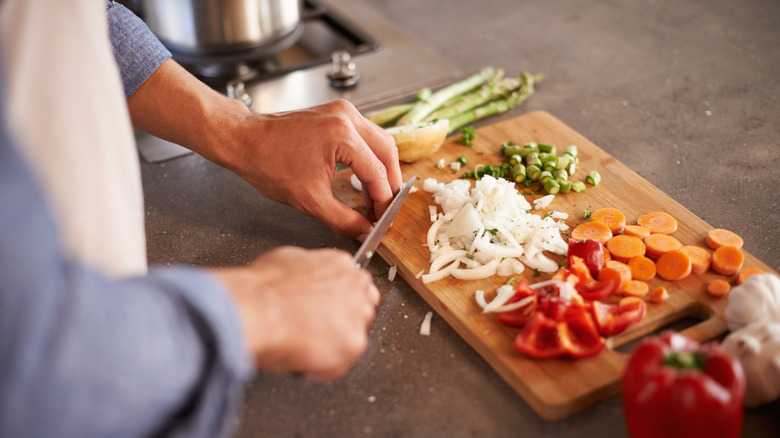When it comes to maintaining a pristine kitchen environment, knowing how to clean a cutting board with lemon is essential for kitchen professionals. Cutting boards are often the most used items in any kitchen and can harbor bacteria if not cleaned properly. Using lemon not only cleans but also acts as a natural disinfectant. This article will guide you through the steps, tips, and importance of keeping your cutting board in top shape using lemon, a common yet potent resource found in most kitchens.
Before diving into the process, its vital to understand the different types of cutting boards and their care needs. Wood, plastic, and bamboo boards each require distinct cleaning methods. However, this article will primarily focus on the cleaning process that utilizes lemon, which is suitable across most types of cutting boards.

The Importance of Clean Cutting Boards
Cutting boards are breeding grounds for bacteria, as they often encounter raw meat, vegetables, and other food ingredients. According to a study by the Food Safety Blog, improper maintenance of cutting boards can result in cross-contamination. Professional chefs know that maintaining a hygienic space boosts food safety and therefore enhances the quality of culinary creations.
Essential Supplies for Lemon Cleaning
To clean a cutting board effectively with lemon, here are a few essential supplies you will need:
- Fresh lemons: Choose ripe ones for optimal acidity.
- Salt: A natural abrasive that works well with lemon juice.
- Clean cloth or paper towels: For drying the board later.
- Non-toxic sponge or scrubber: For any stubborn stains.
Step-by-Step Cleaning Process
Now that you have gathered your supplies, lets walk through the step-by-step process of how to clean a cutting board with lemon.
1. Initial Rinse
Start by rinsing the cutting board under warm, running water. This helps to remove loose food particles and makes the surface easier to clean.
2. Sprinkle Salt
Evenly sprinkle coarse salt over the surface of the cutting board. Salt acts as a natural abrasive that can scrub away stains and bacteria effectively.
3. Squeeze Lemon Juice
Cut a lemon in half and squeeze one of the halves over the salted cutting board. Allow the citrus juice to mingle with the salt, creating a scrub that enhances cleaning.
4. Scrub and Clean
Using the lemon half, start scrubbing the cutting board in circular motions. The combination of salt and the acidity of lemon will work to lift stains and kill bacteria on the surface.
5. Rinse Thoroughly
After scrubbing, rinse the cutting board under warm water again to remove any residual lemon juice and salt. Ensure no grit is left behind.
6. Dry Completely
Finally, use a clean cloth or paper towel to dry the cutting board thoroughly. Allowing it to air dry can sometimes lead to warping, so ensure its dry before storing it away.
Deep Cleaning with Lemon
For cutting boards with heavy stains, a deeper cleaning method can be employed. Consider mixing lemon juice with baking soda to form a paste that can be applied to tough spots. Let it sit for a few minutes before scrubbing.
Maintaining Your Cutting Board
Knowing how to clean a cutting board with lemon is essential, but it is just as important to maintain it. Regular cleaning and conditioning keep your board in optimal condition.
Using Mineral Oil
For wooden cutting boards, it is advisable to condition them with mineral oil regularly. This prevents cracking and maintains the boards integrity. For a detailed guide, check out this article on using mineral oil.
Refinishing Your Board
Sometimes, cutting boards may need refinishing to restore their look and feel. Learn more about how to do that from our guide here: refinishing cutting boards.
Safety Tips for Cutting Board Maintenance
- Always wash your hands before handling your cutting boards.
- Use separate boards for raw meat and vegetables to prevent cross-contamination.
- Regularly inspect your cutting boards for deep grooves or scratches, which harbor bacteria.
- Dont soak wooden boards in water, as it may warp or crack.
Common Mistakes to Avoid
Even seasoned kitchen professionals can make common mistakes when it comes to cleaning cutting boards. Heres a brief list of pitfalls to avoid:
- Not using enough lemon juice: A weak solution wont effectively clean your board.
- Using harsh chemicals: Avoid bleach and other strong cleaners that could be harmful.
- Neglecting to dry: Failing to dry the board can lead to mold growth.
:max_bytes(150000):strip_icc()/prevent-cutting-board-slipping-1123-c9837c7f958745b792c2b115c7d7bccd.jpg)
FAQs
Can I use other citrus fruits besides lemon?
Yes! Other citrus fruits like lime or orange can also work but may have less antibacterial properties compared to lemon.
How often should I clean my cutting board?
It is advisable to clean your cutting board after each use, especially when dealing with raw meat.
Is it safe to use lemon for plastic cutting boards?
Absolutely! Lemon is safe for plastic cutting boards and can help eliminate odors.
In conclusion, knowing how to clean a cutting board with lemon effectively is crucial for kitchen professionals who aim for cleanliness and safety in food preparation. For a more elaborate understanding of cutting board hygiene, you can also visit this Clean Eating Magazine article. Proper maintenance not only extends the life of your kitchen tools but ensures that you always work optimally.
As an Amazon Associate, I earn from qualifying purchases.


























